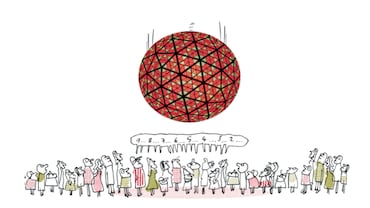- HOME
- /
- Odds and Ends
- /
- Who knew
- /
24-Karat Nuggets About Gold
Fascinating facts about our favourite precious metal
 Illustration by Serge Bloch; scyther5/Getty Images (gold nugget)
Illustration by Serge Bloch; scyther5/Getty Images (gold nugget)
1. Pure gold is so ductile (translation: stretchy), a mere 28 grams of it can be drawn out into a thread 80 km long without breaking (at which point it also would be too thin to see). If you did this to all of the existing gold in the world, it would wrap around the earth 11 million times.
2. Contrary to popular belief, biting on gold is not a reliable way to tell whether it’s genuine—other metals are also soft enough to show teeth marks. And though many champs chomp down on their prizes, Olympic gold medals haven’t been made from that metal since the 1912 Summer Games in Stockholm. Modern gold medals are mostly silver; those from the 2016 Games in Rio contained only 1.2 per cent gold.
3. The Nobel Prize medal is still made of gold, though it was downgraded in 1980, when it went from 23 karats (24 is pure) to an 18-karat core coated in 23-karat gold. The gold in each medal is worth about $8,000 (Rs 6,00,700).
4. A naturally yellow element, gold changes colour when mixed with other metals, which also gives it added strength. White gold contains nickel or palladium. Rose gold gets its hue from copper. There’s even green gold, which has silver and sometimes zinc or cadmium. To determine how much gold is in any piece, divide the karat content by 24 and multiply by 100. The resulting percentage is the amount that is gold.
5. Gold has been used in medicine for millennia. The ancient Romans made dental bridges out of it, a practice they learnt from the Etruscans. For much of the 20th century, doctors reduced their rheumatoid arthritis patients’ pain and swelling with intramuscular injections of gold compounds that have anti-inflammatory properties. Today, some oncologists use gold compounds to shrink cancerous tumours.
6. The term ‘bullion’, which refers to gold bars or coins ready to be traded, comes from the Latin word for ‘boil’. That’s how to remove gold’s impurities—at a mere 2,856 degrees C.
7. The U.S. Treasury currently holds 147.3 million ounces of gold bullion. About half of it is stored at Fort Knox, a stash that’s worth more than $130 billion. Security at Fort Knox is so tight, only one president has ever been inside the vaults: Franklin Delano Roosevelt, the same president who effectively took us off the gold standard in 1933. (The United States didn’t fully abandon it until 1971.)
8. Most of the world’s gold is now mined in China. The country overtook South Africa for total historical gold production in 2017. But the world’s largest gold crystal—an extremely rare geometric formation that can appear on gold specimens—weighed 7.7 ounces and was found decades ago in Venezuela.
9. Among the more surprising—and unpleasant—sources of gold: treated sewage. In 2015, after analyzing sewer sludge from local treatment plants, researchers at Arizona State University concluded that the sewage produced each year in a city of a million people includes, on average, $2.6 million [Rs 1,94,59,817] worth of gold and silver.
10. We have already extracted about 80 per cent of the world’s 2,44,000 mineable tons of gold. Ocean waters and seabeds contain about 20 million more tons, but this treasure remains largely untouched because of the prohibitive costs to tap it. But the biggest trove is in outer space. One asteroid alone (called 16 Psyche) has a few hundred quintillion dollars’ worth.
11. But so far, we’ve only brought gold to space, not taken any from it. Space suits and spacecraft are coated in gold to reflect harmful infrared radiation from the sun. Any instrument NASA wants to keep cool gets a gold coating as well (since radiation is also a great source of heat). This includes the James Webb telescope, the world’s most powerful space telescope, set to be launched later this year.
12. Pyrite, the mineral better known as fool’s gold, has fooled many, including the famed English seaman and founder of the Jamestown colony, Christopher Newport, who sailed a shipload of it to London in the 1600s. Although pyrite can be a disappointing find, it is often discovered near sources of real gold, so a miner who stops digging once he finds a piece of pyrite may be the real fool.
13. Don’t go looking for a pot of the precious metal at the end of a rainbow. One version of this legend is more of a cautionary tale: When a poor Irish husband and wife pull the last carrot out of their garden, they catch a leprechaun dangling from it. The leprechaun agrees to grant all their wishes if they find his pot of gold at the end of the rainbow, leaving them to forever chase a fictitious fortune.






